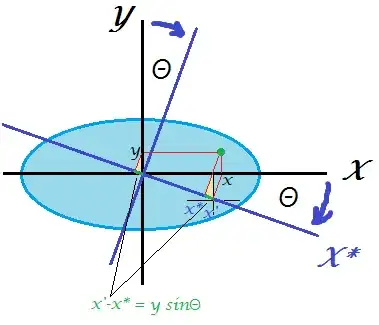It is not completely clear to me that what you are asking is what you really need: a common preprocessing step in machine learning is dimensionality reduction + whitening, which means doing PCA and standardizing the components, nothing else. But I will nevertheless focus on your question as it is formulated, because it's more interesting.
Let $\mathbf X$ be the centered $n\times d$ data matrix with data points in rows and variables in columns. PCA amounts to singular value decomposition $$\mathbf X = \mathbf{USV}^\top \approx \mathbf U_k \mathbf S_k \mathbf V_k^\top,$$ where to perform the dimensionality reduction we keep only $k$ components. An orthogonal "factor rotation" of these components implies choosing an orthogonal $k \times k$ matrix $\mathbf R$ and plugging it into the decomposition: $$\mathbf X \approx \mathbf U_k \mathbf S_k \mathbf V_k^\top = \mathbf U_k \mathbf {RR}^\top \mathbf S_k \mathbf V_k^\top = \underbrace{\sqrt{n-1}\mathbf U_k^\phantom\top \mathbf {R}}_{\substack{\text{Rotated}\\\text{standardized scores}}} \cdot \underbrace{\mathbf R^\top \mathbf S_k \mathbf V_k^\top/\sqrt{n-1}}_{\text{Rotated loadings}^\top}.$$ Here $\sqrt{n-1}\mathbf U_k \mathbf R$ are rotated standardized components and the second term represents rotated loadings transposed. The variance of each component after rotation is given by the sum of squares of the corresponding loading vector; before rotation it is simply $s_i^2/(n-1)$. After rotation it is something else.
Now we are ready to formulate the problem in mathematical terms: given unrotated loadings $\mathbf L = \mathbf V_k \mathbf S_k / \sqrt{n-1}$, find rotation matrix $\mathbf R$ such that the rotated loadings, $\mathbf L \mathbf R$, has equal sum of squares in each column.
Let's solve it. Column sums of squares after rotation are equal to the diagonal elements of $$(\mathbf {LR})^\top \mathbf{LR} = \mathbf R^\top \frac{\mathbf S^2}{n-1} \mathbf R.$$ This makes sense: rotation simply redistributes the variances of components, which are originally given by $s_i^2/(n-1)$, between them, according to this formula. We need to redistribute them such they all become equal to their average value $\mu$.
I don't think there is a closed form solution to this, and in fact there are many different solutions. But a solution can be easily built in a sequential fashion:
- Take the first component and the $k$-th component. The first one has variance $\sigma_\text{max}>\mu$ and the last one has the variance $\sigma_\text{min}<\mu$.
- Rotate only these two such that the variance of the first becomes equal to $\mu$. Rotation matrix in 2D depends only on one parameter $\theta$ and it is easy to write down the equation and compute the necessary $\theta$. Indeed, $$\mathbf R_\text{2D} = \left(\begin{array}{cc}\cos \theta & \sin \theta \\ -\sin\theta & \cos \theta\end{array}\right)$$ and after transformation the first PC will get variance $$\cos^2\theta \cdot \sigma_\text{max} + \sin^2\theta \cdot \sigma_\text{min} = \cos^2\theta \cdot \sigma_\text{max} + (1-\cos^2\theta)\cdot \sigma_\text{min} =\mu,$$ from which we immediately obtain $$\cos^2\theta = \frac{\mu-\sigma_\text{min}}{\sigma_\text{max}-\sigma_\text{min}}.$$
- The first component is now done, it has variance $\mu$.
- Proceed to the next pair, taking the component with the largest variance and the one with the smallest variance. Goto #2.
This will redistribute all variances equally by a sequence of $(k-1)$ 2D rotations. Multiplying all these rotation matrices together will yield the overall $\mathbf R$.
Example
Consider the following $\mathbf S^2/(n-1)$ matrix: $$\left(\begin{array}{cccc}10&0&0&0\\0&6&0&0\\0&0&3&0\\0&0&0&1\end{array}\right).$$ The mean variance is $5$. My algorithm will proceed as follows:
Step 1: rotate PC1 and PC4 so that PC1 gets variance $5$. As a result, PC4 gets variance $1+(10-5)=6$.
Step 2: rotate PC2 (new maximal variance) and PC3 so that PC2 gets variance $5$. As a result, PC3 gets variance $3+(6-5)=4$.
Step 3: rotate PC4 (new maximal variance) and PC3 so that PC4 gets variance $5$. As a result, PC3 gets variance $4+(6-1)=5$.
Done.
I wrote the Matlab script that implements this algorithm (see below). For this input matrix, the sequence of rotation angles is:
48.1897 35.2644 45.0000
Component variances after each step (in rows):
10 6 3 1
5 6 3 6
5 5 4 6
5 5 5 5
The final rotation matrix (product of three 2D rotation matrices):
0.6667 0 0.5270 0.5270
0 0.8165 0.4082 -0.4082
0 -0.5774 0.5774 -0.5774
-0.7454 0 0.4714 0.4714
And the final $(\mathbf{LR})^\top \mathbf{LR}$ matrix is:
5.0000 0 3.1623 3.1623
0 5.0000 1.0000 -1.0000
3.1623 1.0000 5.0000 1.0000
3.1623 -1.0000 1.0000 5.0000
Here is the code:
S = diag([10 6 3 1]);
mu = mean(diag(S));
R = eye(size(S));
vars(1,:) = diag(S);
Supdated = S;
for i = 1:size(S,1)-1
[~, maxV] = max(diag(Supdated));
[~, minV] = min(diag(Supdated));
w = (mu-Supdated(minV,minV))/(Supdated(maxV,maxV)-Supdated(minV,minV));
cosTheta = sqrt(w);
sinTheta = sqrt(1-w);
R2d = eye(size(S));
R2d([maxV minV], [maxV minV]) = [cosTheta sinTheta; -sinTheta cosTheta];
R = R * R2d;
Supdated = transpose(R2d) * Supdated * R2d;
vars(i+1,:) = diag(Supdated);
angles(i) = acosd(cosTheta);
end
angles %// sequence of 2d rotation angles
round(vars) %// component variances on each step
R %// final rotation matrix
transpose(R)*S*R %// final S matrix
Here is the code in Python provided by @feilong:
def amoeba_rotation(s2):
"""
Parameters
----------
s2 : array
The diagonal of the matrix S^2.
Returns
-------
R : array
The rotation matrix R.
Examples
--------
>>> amoeba_rotation(np.array([10, 6, 3, 1]))
[[ 0.66666667 0. 0.52704628 0.52704628]
[ 0. 0.81649658 0.40824829 -0.40824829]
[ 0. -0.57735027 0.57735027 -0.57735027]
[-0.74535599 0. 0.47140452 0.47140452]]
http://stats.stackexchange.com/a/177555/87414
"""
n = len(s2)
mu = s2.mean()
R = np.eye(n)
for i in range(n-1):
max_v, min_v = np.argmax(s2), np.argmin(s2)
w = (mu - s2[min_v]) / (s2[max_v] - s2[min_v])
cos_theta, sin_theta = np.sqrt(w), np.sqrt(1-w)
R[:, [max_v, min_v]] = np.dot(
R[:, [max_v, min_v]],
np.array([[cos_theta, sin_theta], [-sin_theta, cos_theta]]))
s2[[max_v, min_v]] = [mu, s2[max_v] + s2[min_v] - mu]
return R
Note that this problem is completely equivalent to the following one: given $k$ uncorrelated variables with variances $\sigma_i^2$, find a rotation (i.e. a new orthogonal basis) that will yield $k$ variables with equal variances (but of course not uncorrelated anymore).
